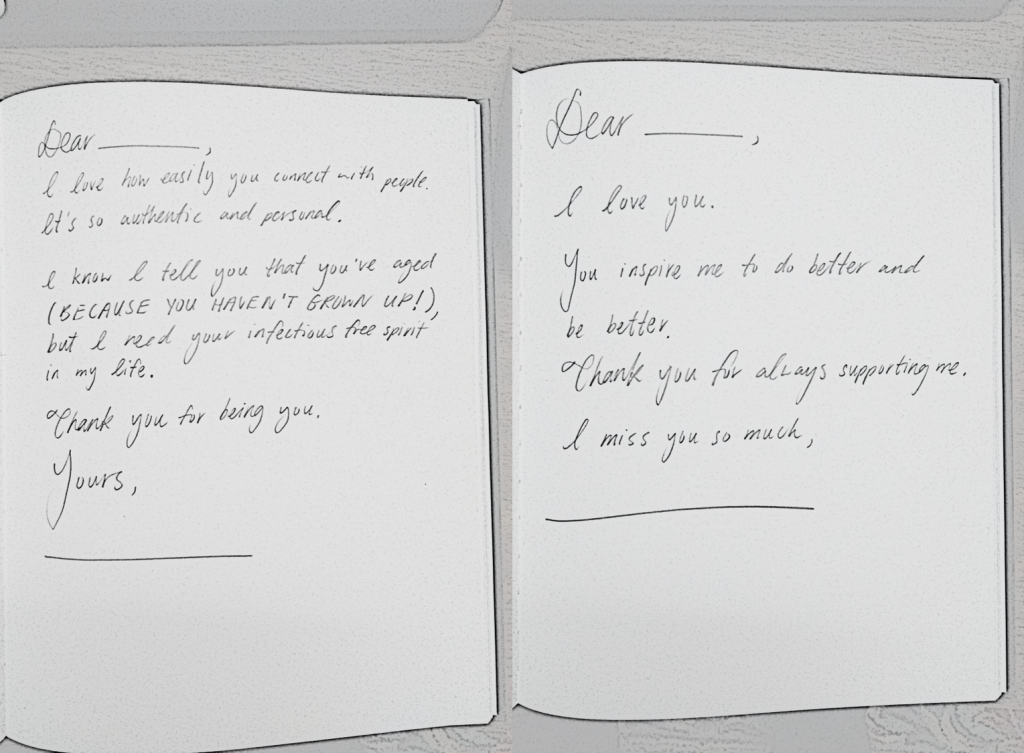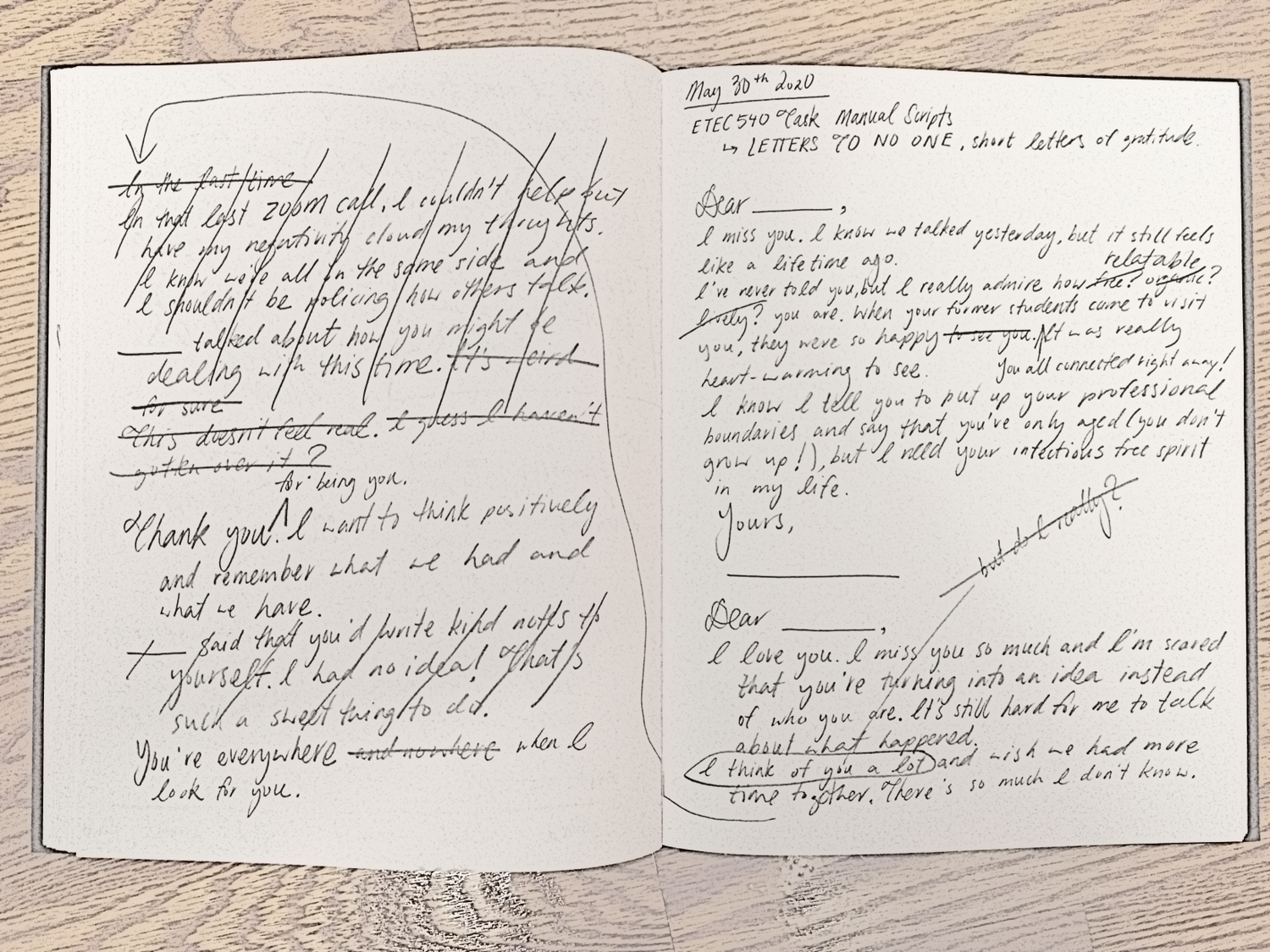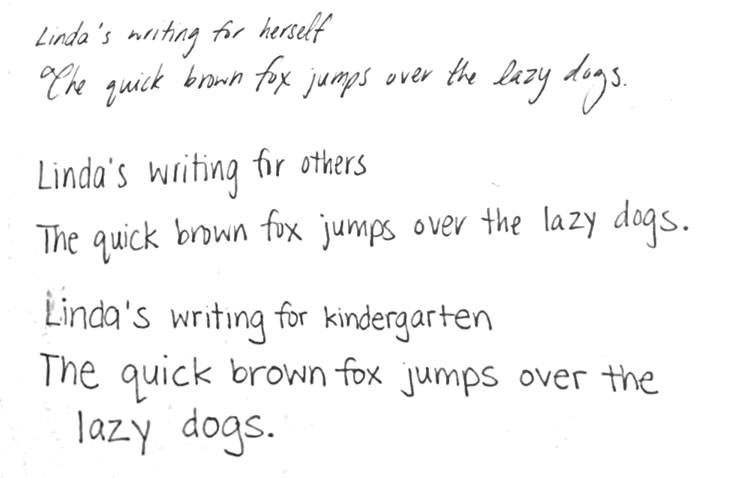Letters to No One
This is the finished product of my two letters to no one. I’ve applied a photocopy filter to the original photograph so that you can more clearly see my writing.

Do you normally write by hand or type? Did you find this task difficult or easy? Explain.
I write by hand and type depending on my task. These days, I mostly type but will switch back to handwriting when I need to draft something. I also switch to handwriting when I get too distracted by technology or have a writer’s block. Writing helps me just get any thoughts that I have out. Somehow, type seems a bit more permanent while writing by hand offers me more freedom to think and create.
This specific task was easy because I knew what I wanted to write and I didn’t get caught up in how my text looked aesthetically. The letters above are the finished copies, but my rough work is not as aesthetically polished.
What did you do when you made a mistake or wanted to change your writing? How did you edit your work? Did your choice of media play a part in how you edited your work?

I chose to make “good copy” texts so I’ve included my rough work so that you can see my process. To edit my work, I cross out text, use carets to insert text, draw arrows to show the continuity, and circle text to add my own commentary. In this case, I did not do a lot of editing, but I will use different stationery (e.g., coloured pens, highlighters) to layer edits or commentary onto the original draft. To create my “good copy”, I chose to write my condensed text on new pages. If you compare the draft work and the “good copy”, you’ll notice that I’ve cut many words and it can seem like I’ve censored some of my messages to the recipients. However, this is because I use the process of handwriting to embody my thinking. The act of writing is an opportunity for me to sort out my thoughts and piece them together. The “good copy” might be the text for the recipient, but the rough work is the text for me and my personal use.
Unlike typing, handwriting is forced to generate a physical artifact. If this was a more complex task, I can return to my draft to unravel my process thinking. I can identify nuggets of realization and shifts in my thinking if I take the time to compare them to the “good copy”.
What do you feel is the most significant difference between writing by hand and using mechanized forms of writing? Which do you prefer and why?
Handwriting is so personal and puts a lot of emphasis on the intimacy and value of the text while mechanized forms of writing allow for easy distribution.
In my letters to no one, I am writing for myself and this is reflected in the nuances in how the characters were formed:
- I write in italics with a right facing slant with cursive artifacts: My writing is a mix of cursive and print. Cursive has pretty letters and lets me write faster. I avoid going full cursive because my cursive isn’t always legible. I love typography and calligraphy so tend to stylize my text to personalize it.
- I incorporate non-English letters in my writing for decorative purposes: When I write a capital ‘T’, I actually write stylize the Greek letter tau. There isn’t a sample of it in this task, but I will model a capital ‘H’ after a stylized Hamiltonian operator I saw in a textbook.
When I write for others, I switch to printing where my letters are non-italicized and try to emphasize legibility. I end up slowing down my writing to focus on this.

When I switch from typing to handwriting, it’s usually done because I can’t focus when I’m at my computer. The handwritten text will later be mechanically transferred into a digital medium. In this case, I don’t really care about the physical text I produced because the act of creation is more important. I often throw out this paper as its only purpose was to help me focus on thinking rather than the final deliverable.
Overall, I prefer handwriting because I feel more in control. Somehow, the intimacy of this technology and its affordances lets me slow down and focus on what I want to express. Since typing is heavily tied to my computer, I have a bad habit of task switching and getting distracted by other things I could be doing.
In some ways, working at a computer some how leads to a more permanent text because of its ease for mass distribution. Sometimes this pressures me in trying to create something perfect. As a comparison, when I used to draw I could always do quick sketches easily but when I had to draw something that was intended to be a “good copy”, I would freeze. What I find liberating in these times is to draw with my non-dominant hand. It doesn’t look good, but the drawing gets done.

Hello Linda!
I really enjoyed how you described your process of writing a letter. When writing by hand, we repeat ourselves through copies to not only refine *what* we say but also what we say through how it *looks*. You got me pondering with your point on comparing rough copies to the good copy… you don’t get this opportunity with typing unless you save distinct copies. I remember doing just that as a kid (there would be the word-vomit file, the “rough draft”, and the “good copy”). I can’t recall if that’s how I was taught to save my files, or if I just did that on my own because I enjoyed looking at all three and seeing the evolution. I wonder if that’s a file-saving step we should be teaching our young computer-users, so that they do not miss this opportunity to reflect.
I completely agree that handwriting gives more creative freedom, but for different reasons. To me, it feels much more permanent, even when I’m writing on good-oneside paper! It also slows down the flow of getting my words out, if I want to be at all legible (interesting sidenote— mixing cursive and print is the most effecient way to write! During my undergrad, I had a prof who made us race to copy down a paragraph and it was us mixies who finished first). However, I find it much more freeing because I’m not constrained to lines of text, one idea after another. Paper lets me bounce around on the page until I’m ready to order my thoughts through type.
Thank you for ideas!
Hi Laura,
That’s a great point about saving distinct files! I’ve noticed that there’s a greater push for cloud based documents (e.g., Google Docs, OneDrive) so revision history is present, but it’s more like the shadow of a text. It’s there, but people don’t really delve into it as they would if there was a separate file. Maybe a portfolio type assignment would help with this where students have to submit a “draft text” and “publish” it.
I had no idea mixing cursive and print is the most efficient way to write! In terms of writing, I know that even selecting the paper I write on can influence how and where I write (e.g., lined paper with margins, grid paper, blank paper).
Hi Linda, thanks for sharing this assignment. I love that you did the hand writing option. I contemplated it and didn’t think it was a good idea for me as my writing has turned into an unreadable scratch. I really love that you wrote three versions of your writing. The kindergarten writing is spot on! For my primary class when I hand write on the board for fun I tell them its “fancy writing” and they try to copy. I also have “teacher” printing writing when we do group brainstorms or I am making a poster. Its funny how we have different ways we write for our audience.
Hi Tyler,
I love your last point: It’s funny how we have different ways we write for our audience.
This really reminds me of oral storytelling and how we might include or exclude certain elements based on the audience. With the kindergarten teacher writing, I think this might be done EXTRA neat because the students are still learning how to read and write. The character forms need to be modelled so that the students can read them and focus on the text’s meaning rather than deciphering the text.